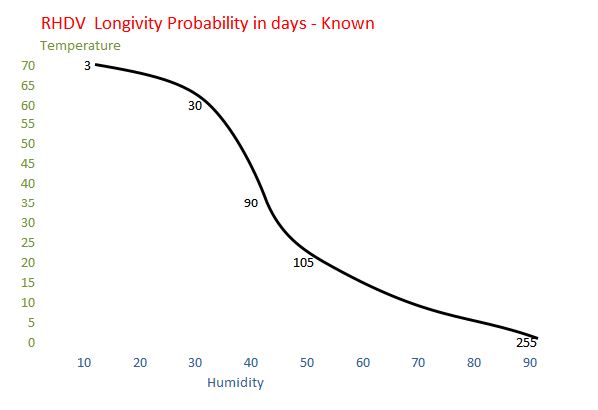by Monique Goosen, 02/07/2024
After recent discussions, I found there is several misconceptions still regarding the spread and timespan of RHDV. I have been asked: But the 120 days is up, so should the virus not be dead?
No.
The number of days given as 105 as was initially, is a guideline, for Infected but recovered rabbits in a controlled environment of between 20 and 28 degrees Celsius, with a drier humidity, as per Gauteng weather. It has later been extended to 120 days in esp the Garden Route Rabbits, where humidity is higher and temperatures are cooler.
The virus does not apply to specific days but to specific weather. With the differences in our regions, the virus in Garden Route does not act the same as in Gauteng, or in Free State.
Now, let’s look at some info and facts:
Hares and rabbits cannot have the virus as “dormant” lifelong. The Virus has been known to lie dormant within a rabbit for up to 3 months, but not lifelong. Instead, they can be AFFECTED BUT IMMUNE and shed it, and be reinfected a few times or even ongoing, They will also act as vectors during their whole time, actively as well as shedding, and constantly reinfecting themselves*
The virus can easily be on surfaces for up to 105 days on a fomite (an object (such as a dish, toy, book, doorknob, or article of clothing) that may be contaminated with infectious agents (as bacteria or viruses) and serve in their transmission.) at room temperature (20degrees celsius.
It can lie in decaying tissue for up to 90 days on the ground, at room temperature.
It can live for many months (up to 7 months has been confirmed ) in chilled conditions, (tests have been taken at about 7 degrees average, so, buried at 1m deep in a cooler environment can have it last even longer.
It can live up to 3 days at an average of 70 degrees (so longer than 3 days because nights are colder).
Rabbits and Hares that became immune do NOT shed life long, except if they are reinfected.
Frozen meat that is infected can release the virus after nearly a year.
Pelts that were kept cool, distributed the virus in a USA state 6 months after their being processed into keyrings.
A cooler room that housed infected rabbit meat showed a positive PCR test 225 days later (kept at 4 degrees Celsius).
Conclusion: There are no “fixed dates”. There are guidelines, which all depend on humidity and room temperature of 20 degrees Celcius. While Rescues were told to quarantine rabbits for 30 days, I have found this esp lacking.

Spreading and Reintroduction:
*Immune, unaffected rabbits are constantly infecting themselves all over. We should be seeing Immune Rabbits as potentially infected, for extended periods of time. While they are not affected, and their immune system can fight the virus, the virus still gets a chance to replicate in them and is excreted. They ingest their cecoprophs, and this can cause to reinfection. They may not show any signs and symptoms, but they are a threat to all rabbits not vaccinated or immune too. Hares
In the garden route, we could trace new cases in April from a site where rabbits have been buried 1m deep, without agricultural lime, and a MOLE dig through there and resurfaced the virus. The mole heaps were on both sides of the burial site, the person lost 12 more rabbits 6 days later.
Any bugs, Any animal, any person that comes in contact with the carcasses is once again a vector (a living thing that carries the disease-causing agent or causative organism from reservoirs to the host)
Properly disposing of the carcasses is one of the main factors to contain the spread. This has not been done at all in the previous outbreak. This increases our risk of re-infections and spreading the disease immensely. A huge number of home breeders slaughtered their rabbits and froze them, for food, this releases the virus each time one is thawed.
Where rabbits die and there is groundwater, the virus can lie up to 6 months in the water itself. It can then be distributed when the ground is being dried. or even when drunk, and this is shed by vectors for 105 + days.
Many rabbits have died underground, and the precautionary steps were not taken to ensure the soil is safe (agricultural lime and cement pumped into holes, or ground properly incinerated to burn the virus.
People and the government have not taken the proper steps to ensure the disease does not come back in infected areas.
It is per law the responsibility of the OWNERS and CARETAKERS of any animals to ensure that the disease is contained, and correctly handled, and ensure that the proper measures have been taken to stop any further outbreaks. Those who have not correctly treated, buried and quarentined after having positive cases, are the people that will be directly responsible for the first surge hits, and their areas will remain an infection site, where others will take the decease from and introduce to their homes.
Based on the professional research done by others, after I have studied over 200 articles by approved, known authentic scientists.
Added Info and References:
RHD (1) RHDVFAQ RHDV2-SOP-20200515
rabbit-haemorrhagic-disease-guidance-document-version1-25-november-2022 (1)
https://acrobat.adobe.com/id/urn:aaid:sc:EU:07857506-c718-4c68-bc4b-ef496139dcb7
https://acrobat.adobe.com/id/urn:aaid:sc:EU:be1b671c-4231-47cd-af7a-304523674599
https://acrobat.adobe.com/id/urn:aaid:sc:EU:afbe83ee-8a6b-455a-8320-06cb696cc650
https://acrobat.adobe.com/id/urn:aaid:sc:EU:9ed64d4c-5760-4e10-b473-8c16b95b0dc3
